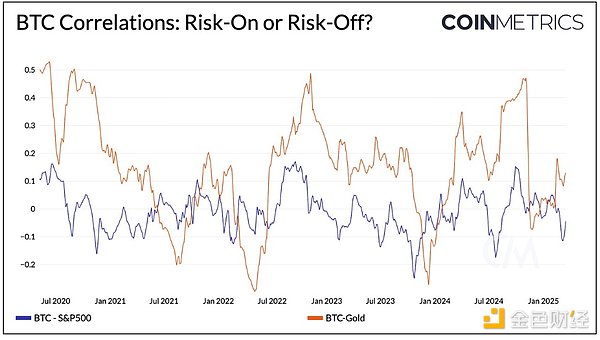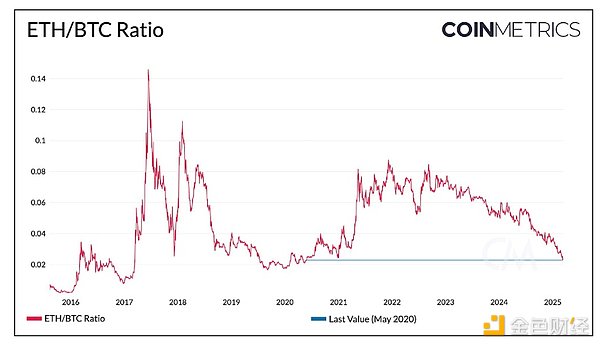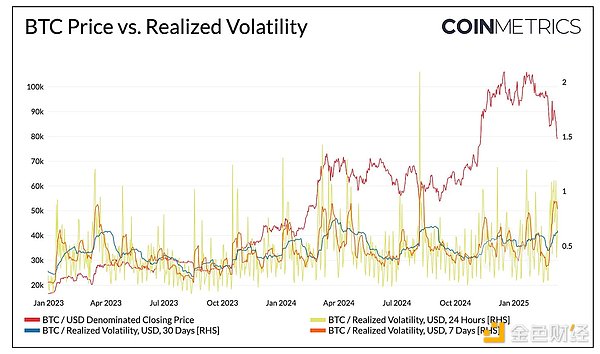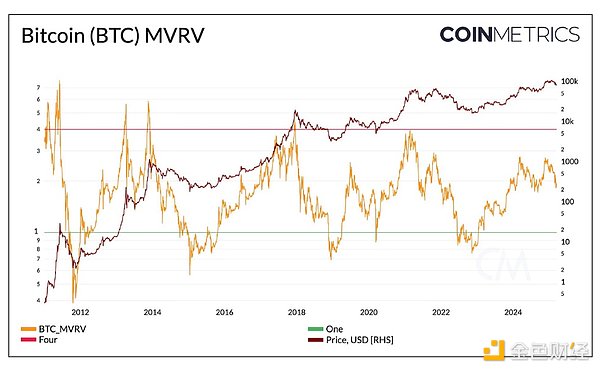Author: Tanay Ved, Coin Metrics analyst; Compiler: Jinse Finance xiaozou
Abstract:
The crypto market is under the dual pressure of macroeconomic headwinds and industry-specific challenges, and volatility has increased again.
Bitcoin remains largely uncorrelated with traditional assets such as gold and the S&P 500, highlighting its unique positioning in the current macro environment.
Bitcoin's dominance continues to rise, reinforcing a market structure driven by institutional capital, while retail participation remains low.
Market conditions remain uncertain, but improving macro dynamics, regulatory clarity, and shifts in capital flows could lay a solid foundation for long-term market growth.
1Introduction
Rotten by waves of volatility and uncertainty, digital asset markets are caught in the crossfire of macroeconomic pressures and crypto-specific factors. Just a few weeks ago, BTC was consolidating around $100,000, with market participants optimistic about a new round of growth under more supportive governments and structural catalysts. Today, as BTC hovers around $80,000, market sentiment has clearly shifted. Speculation has cooled, the Bybit hack has heightened unease, and economic uncertainty has weakened risk appetite. However, there are still positive developments, such as the establishment of the US Strategic Bitcoin Reserve and a constructive shift in the regulatory approach to the crypto industry.
In this article, we assess the drivers behind recent crypto market weakness and where we are in the broader market cycle, exploring the macroeconomic and crypto-specific factors that are shaping the path forward.
2Macro Factors
Both the broader stock market and crypto assets have experienced a turbulent few months, undoing their post-election gains. The primary driver of this volatility has been growing macroeconomic pressures in the form of Trump’s aggressive trade policies, retaliatory measures from key U.S. trading partners, and escalating geopolitical tensions—all of which have combined to create an environment of uncertainty that has weighed on inflation expectations and economic growth.
Despite seemingly positive developments, such as the creation of a strategic reserve of Bitcoin ahead of the first White House crypto summit, the SEC’s withdrawal of a high-profile lawsuit, and growing institutional momentum, macroeconomic headwinds and recent industry-specific challenges have continued to weigh on digital asset markets.

In the current uncertain market environment, gold has soared above $3,000, and investors have flocked to this premier safe-haven asset. At the same time, the S&P 500 and Nasdaq Composite Index have fallen 3.8% and 8.2% year-to-date, respectively, and risk appetite has weakened. However, Bitcoin seems to be caught between these two forces. Although often regarded as "digital gold" and a tool to hedge against inflation or market instability, BTC has not yet established a meaningful correlation with gold, and its 90-day correlation with the S&P 500 and gold remains weak (around 0), pointing to its irrelevance and ambiguous role in the current market mechanism.
3Internal factors of the crypto market
(1) Are retail investors still there?
While larger macro forces play a major role, the intrinsic dynamics of crypto assets continue to shape the market in unique ways. Bitcoin (BTC) remains the main market driver and a barometer of the market's overall risk appetite. Bitcoin's dominance (a measure of its market capitalization as a percentage of the entire crypto market) has steadily climbed from 37% in November 2022 to 61% today. While this has been a feature of past cycles, structural shifts such as the launch of spot Bitcoin ETFs and demand from corporate holders such as MicroStrategy have amplified this Bitcoin-driven market structure. Altcoin dominance has approached 39%. While the decline in Bitcoin dominance has long signaled a rotation into altcoins, marking the start of an “altcoin season,” a reversal of the current trend remains elusive. The continued weakness in altcoins may reflect a growing divergence between institutional and retail sentiment, which is also evident in spot trading volumes. While altcoins in general have struggled to keep pace, meme coins have become the preferred vehicle for retail speculation. However, the recent cooling in the space has further dampened retail sentiment.

(2)ETHPoor performance and altcoin divergence
Another influencing factor is Ethereum (ETH)'s continued poor performance relative to Bitcoin (BTC). Historically, changes in ETH/BTC have been correlated with changes in altcoin dominance, with altcoin dominance rising when ETH/BTC weakness reversed in 2017, 2018, and 2021. The current ETH/BTC ratio is 0.022, which is at the level of May 2020.
While this underperformance can be attributed to Ethereum's own challenges, such as reduced L1 activity, value accumulation in L2, and competition from other L1s, it has also suppressed broad altcoin sentiment. The reversal of ETH/BTC, coupled with an improving macro outlook and regulatory clarity, could be a potential catalyst for altcoins, especially those with more solid foundations and clearer investment themes in structural growth areas.
3Rising Volatility, Leverage Reset
BTC is volatile. Although BTC's volatility has weakened over time, it is still prone to large declines and price swings. Recently, we can see that daily volatility is rising, with BTC's 7-day realized volatility reaching 0.9 on a decline of about 25%.

This volatility has recently triggered a wave of liquidations in spot and derivatives markets. However, the Bitcoin futures market shows that positions are healthier than a few months ago. Futures open interest has fallen to pre-November election levels, indicating that excess leverage has been cleared. The ratio of futures open interest to its market value has also fallen, indicating that speculative positions have reset. This provides a more stable foundation for the next stage of growth.
4Where are we in the cycle? What's next?
Given the current environment, where are we relative to previous “cycles”? Among many indicators, Bitcoin’s MVRV ratio (which measures the ratio of Bitcoin’s market capitalization to its realized value — the sum of the last coin transfer price on the chain) can serve as a useful indicator of cycle positioning. Historically, high ratios (>3.5) have indicated an overheated market, while low ratios (1) have indicated an attractive accumulation zone.
Currently, Bitcoin’s MVRV ratio is 1.9, having peaked at nearly 2.65 earlier this year. This places its current position above the bear market lows, but below past cycle peaks, suggesting that we are in the mid-term reset phase. While historical trends provide a useful framework, structural shifts (such as ETF-driven demand, evolving investor profiles, and regulatory clarity) could reshape how this cycle plays out and how we understand it relative to past cycles.

Looking ahead, the medium- to long-term outlook remains positive. Expectations of a highly supportive government and SEC are being fulfilled. Regulatory clarity in areas such as custody and bank participation, stablecoins, and tokenization of real-world assets (RWAs) could unleash a wave of mass adoption.
While the macroeconomic outlook remains uncertain, the foundation has been laid, and interest rate cuts and the start of a new round of liquidity could help drive the next phase of market growth as structural shifts take effect.
 Catherine
Catherine







